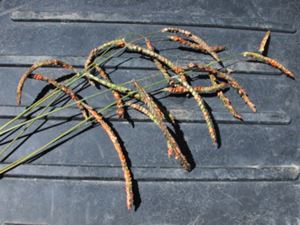Late Summer Flush Of Dallisgrass Can Lead To Ergot Poisoning In Cattle
LITTLE ROCK, ARK.
Grass seedheads that cattle find delicious could turn fatal if the
seedheads are covered in ergot fungus, said John Jennings,
professor-forages, for the University of Arkansas System Division of
Agriculture.
Dallisgrass is very common in the southern half of the state and grows
in low, moist soils. As a forage, it’s high quality and very palatable
for most grazing livestock. The problem is the fungus, named Claviceps
paspali and commonly called ergot, which infects the dallisgrass
flowers. As the plant grows, the fungus replaces the seed. The fungus
contains alkaloids that can affect the livestock’s nervous system.

“Ergot poisoning, also known as ‘dallisgrass staggers’ is a problem in
late summer and early fall,” he said. “The rainy weather in August led
to a flush of dallisgrass forage and the seedheads are commonly infected
with ergot.”
Jennings said the most common scenario for ergot poisoning occurs when
new cattle, not previously exposed to dallisgrass, are brought onto a
farm and are turned into a field that is at the full seedhead stage.
Cattle selectively graze seedheads and that can lead to a very high
dosage of ergot alkaloids. Even on farms where cattle are previously
exposed to dallisgrass, poisoning can occur when animals are hungry and
are turned into a field full of seedheads. Symptoms are much less common
in herds exposed to dallisgrass in mixed grass pastures.
“In the very early stages of the disease, the only sign seen may be
trembling of various muscles after exercise,” Jennings said. “As the
disease progresses, the animal becomes uncoordinated with continuous
shaking of the limbs and nodding of the head.”
Eventually, a severely affected animal may stagger, walk sideways, or
use a goose-stepping gait. Death can occur in severe cases.
“There is no cure for ergot poisoning, but removing cows from infected
pastures when symptoms are first noticed usually results in uneventful
recovery in three to five days,” he said. “Clipping seedheads to prevent
animals from grazing them helps prevent the problem from occurring.
Ergot toxicity from dallisgrass hay is very uncommon since the total
intake of hay forage dilutes any ergot contained in the hay.”∆